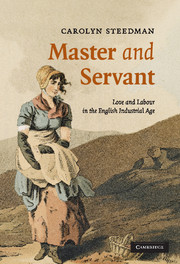Book contents
- Frontmatter
- Contents
- List of maps
- Acknowledgements
- Map 1 Map of the Haworth, Slaithwaite, Huddersfield and Halifax region, 1795
- Map 2 Sketch map of the woollen and worsted producing areas of the West Riding, late eighteenth century
- Prologue
- 1 Introduction: on service and silences
- 2 Wool, worsted and the working class: myths of origin
- 3 Lives and writing
- 4 Labour
- 5 Working for a living
- 6 Teaching
- 7 Relations
- 8 The Gods
- 9 Love
- 10 Nelly's version
- 11 Conclusion: Phoebe in Arcadia
- Bibliography
- Index
2 - Wool, worsted and the working class: myths of origin
Published online by Cambridge University Press: 06 January 2010
- Frontmatter
- Contents
- List of maps
- Acknowledgements
- Map 1 Map of the Haworth, Slaithwaite, Huddersfield and Halifax region, 1795
- Map 2 Sketch map of the woollen and worsted producing areas of the West Riding, late eighteenth century
- Prologue
- 1 Introduction: on service and silences
- 2 Wool, worsted and the working class: myths of origin
- 3 Lives and writing
- 4 Labour
- 5 Working for a living
- 6 Teaching
- 7 Relations
- 8 The Gods
- 9 Love
- 10 Nelly's version
- 11 Conclusion: Phoebe in Arcadia
- Bibliography
- Index
Summary
This place, this ‘narrow bit of hill country’ dividing Yorkshire from Lancashire in which the Colne and Calder valleys lie, has been a land of myth for a very long time. It was, according to E. P. Thompson, the locus classi of ‘the outstanding fact of the period 1790 and 1830 … the formation of the “working class”’. Through countless readings and appropriations of The Making of the English Working Class, through all the historical work that has confirmed and readjusted the account first published in 1963, what he told in it has acquired the status of myth – a foundational account of modern English society, and of the birth of the social classes that accompanied the early stages of its capitalist development. According to the imaginative strictures of classical mythology, then, we may see a Colossus striding out among the hills. There is, first of all, the ancient and amiable Reverend John Murgatroyd, accompanying his maidservants to the putter-out, the small-time merchant wool comber who supplied the worsted bundles that they would, over the next few weeks, spin into yarn in the spaces of time between the domestic services they were contracted with him to provide. He always went with a new girl, to show her the way; in March 1782, for example, he went ‘to Halifax; our Servt. Betty with me to Hollawell=Green & took 5 lbs of yarn, & brought back 9 lbs o' Wool – this her first Time of going – So now She knows ye. Way –’.
- Type
- Chapter
- Information
- Master and ServantLove and Labour in the English Industrial Age, pp. 29 - 46Publisher: Cambridge University PressPrint publication year: 2007



